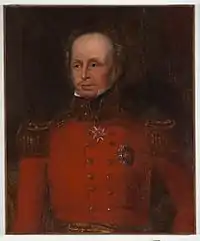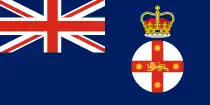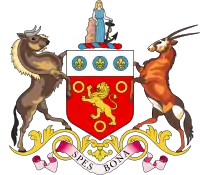Richard Bourke
General Sir Richard Bourke, KCB (4 May 1777 – 12 August 1855), was an Irish-born British Army officer who served as Governor of New South Wales from 1831 to 1837. As a lifelong Whig (Liberal), he encouraged the emancipation of convicts and helped bring forward the ending of penal transportation to Australia. In this, he faced strong opposition from the landlord establishment and its press. He approved a new settlement on the Yarra River, and named it Melbourne, in honour of the incumbent British prime minister, Lord Melbourne.
Sir Richard Bourke KCB | |
|---|---|
 Bourke by Martin Archer Shee (c. 1837–1850) | |
| 8th Governor of New South Wales | |
| In office 3 December 1831 – 5 December 1837 | |
| Monarch | William IV |
| Preceded by | Sir Ralph Darling |
| Succeeded by | George Gipps |
| Personal details | |
| Born | 4 May 1777[1] Dublin, Ireland |
| Died | 12 August 1855 (aged 78)[1] County Limerick, Ireland |
| Spouse(s) | Elizabeth Jane Bourke |
| Military service | |
| Allegiance | United Kingdom |
| Branch/service | British Army |
| Rank | General |
| Battles/wars | Napoleonic Wars |
| Awards | Knight Commander of the Order of the Bath |
Early life and career
Born in Dublin, Ireland, Bourke was educated at Westminster and read law at Christ Church, Oxford. He was a cousin of Edmund Burke and spent school and university holidays at Burke's home, and thus acquired some influential friends. He joined the British Army as an ensign in the Grenadier Guards on 22 November 1798, serving in the Netherlands with the Duke of York before a posting in South America in 1807, where he participated in the siege and storming of Montevideo. He was promoted to major general in 1821. He retired from the army after the Peninsular War to live on his Irish estate, but eventually sought government office to increase his income. He was appointed to the Cape Colony and was promoted to Lieutenant-Governor of the Eastern District of the Cape of Good Hope, acting as governor for both the eastern and western districts. Under Bourke's governorship, much was done to reform the old mercantilist system of government inherited from the Dutch East India Company at the Cape.[2]
Public life
Bourke was an avowed Whig. In November 1830, the Whigs won government in a climate of reform. Major-General Bourke was appointed to succeed Sir Ralph Darling, who was also Irish-born, as Governor of New South Wales in 1831. Bourke proved to be an able, if controversial, governor. In most of his efforts, he faced entrenched opposition from the local conservatives: the 'exclusive' faction in the New South Wales Legislative Council, and the Colonial Secretary Alexander Mcleay and the Colonial Treasurer Campbell Riddell. The newspaper The Sydney Morning Herald always opposed him. (The exclusives were hostile to the participation of ex-convicts ('emancipists') in civil life, hence were opposed to changes which moved the colony from military to civil governance.) Bourke described himself as being "pretty much in the situation that Earl Grey would find himself in if all members of his Cabinet were Ultra Tories and he could neither turn them out nor leave them".
Bourke had authority from the Colonial Office to extend trial by jury and substitute civil for military juries in criminal cases. He managed this despite fierce opposition from the legislature, and his 1833 bill for the extension of juries was only passed with his casting vote and with conservative amendments.

Appalled by the excessive punishments doled out to convicts, Governor Bourke initiated the Magistrates Act, which simplified existing regulations and limited the sentence a magistrate could pass to 50 lashes (previously no such limit existed). The bill was passed by the legislature because Bourke presented evidence that magistrates were exceeding their powers and passing illegal sentences, in part because regulations were complex and confusing. However, furious magistrates and employers petitioned the crown against this interference with their legal rights, fearing that a reduction in punishments would cease to provide enough deterrence to the convicts, and this issue was exploited by his opponents.
In 1835, Bourke issued a proclamation through the Colonial Office, implementing the doctrine of terra nullius by proclaiming that Indigenous Australians could not sell or assign land, nor could an individual person acquire it, other than through distribution by the Crown.[3]
Bourke continued to create controversy within the colony by combating the inhumane treatment handed out to convicts, including limiting the number of convicts each employer was allowed to 70, as well as granting rights to emancipists, such as allowing the acquisition of property and service on juries. It has been argued that the abolition of convict transportation to New South Wales in 1840[4] can be attributable to the actions of Bourke.
Bourke abolished the status of the Anglican Church as the state church of New South Wales, declaring each religious denomination on equal footing before the law. He also increased spending on education and attempted to set up a system of public nondenominational schools. He was credited as the first governor to publish satisfactory accounts of public receipts and expenditures.
In 1837, the year of his promotion to lieutenant-general, he was made colonel for life of the 64th (2nd Staffordshire) Regiment of Foot. The same year, he named the town of Melbourne after The 2nd Viscount Melbourne, the British Prime Minister.
Bourke Street in Melbourne's central business district and the town of Bourke were named after him. The County of Bourke, Victoria, which includes Melbourne, and Bourke County, New South Wales, were also named after him. Elizabeth Street, Melbourne, is generally considered to be named in honour of his wife.
The bronze statue of Bourke outside the State Library of New South Wales in Sydney was the first public statue ever erected in Australia. It was dedicated on 11 April 1842.[5] It records his accomplishments as governor in florid detail. It was funded by public subscription and made by Edward Hodges Baily in London.[6]
Bourke was promoted to general in 1851. He died at his residence, Thornfield House, Ahane, in County Limerick, Ireland, on Sunday 12 August 1855[7] and is buried in Stradbally Cemetery in Castleconnell.
Family
Bourke married Elizabeth, daughter of John Bourke, Receiver-General of the land tax for Middlesex; they had a son, Richard, and three daughters; one, Anne Maria, married the Australian administrator and politician Sir Edward Deas Thomson, and was an ancestor of the Barons Altrincham.[8]
In popular culture
- Bourke is a supporting character in the 1937 novel Under Capricorn.
See also
References
- "ORIGINAL CORRESPONDENCE. THE LATE SIR R. BOURKE, K.C.B." The Argus (Melbourne) (2637). Victoria, Australia. 4 December 1855. p. 6. Retrieved 24 February 2017 – via National Library of Australia.
- "The British Take Root The Revolution in Government". New History of South Africa. Tafelberg Publishers. Archived from the original on 23 July 2011. Retrieved 24 February 2011.
- "Governor Bourke's Proclamation 1835 (UK)". Documenting a Democracy: 110 key documents that are the foundation of our nation. National Archives of Australia. Archived from the original on 7 February 2008. Retrieved 5 March 2008.
This document implemented the doctrine of terra nullius upon which British settlement was based, reinforcing the notion that the land belonged to no one prior the British Crown taking possession of it. Aboriginal people, therefore, could not sell or assign the land, nor could an individual person acquire it, other than through distribution by the Crown. ... Although many people at the time also recognised that the Aboriginal occupants had rights in the lands (and this was confirmed in a House of Commons report on Aboriginal relations in 1837), the law followed and almost always applied the principles expressed in Bourke's proclamation. This would not change until the Australian High Court's decision in the Mabo case in 1992.
- http://www.tocal.com/homestead/vandv/vv40.htm
- Monument Australia. Retrieved 5 January 2014
- KS Inglis, Jan Brazier, Sacred Places: War Memorials in the Australian Landscape. Retrieved 5 January 2014
- "SIR RICHARD BOURKE, K.C.B." The Sydney Morning Herald. National Library of Australia. 20 November 1855. p. 4. Retrieved 2 May 2012.
- Burke's Peerage, Baronetage and Knightage, 107th edition, vol. 1, ed. Charles Mosley, Burke's Peerage Ltd, 2003, p. 1288
External links
| Wikimedia Commons has media related to Richard Bourke (Governor of NSW). |
- Images and transcript of Sir Richard Bourke's journal at the State Library of Victoria.
- Hazel King, 'Bourke, Sir Richard (1777–1855)', Australian Dictionary of Biography, Volume 1, Melbourne University Press, 1966, pp 128–133.
- Mennell, Philip (1892). . The Dictionary of Australasian Biography. London: Hutchinson & Co – via Wikisource.
| Government offices | ||
|---|---|---|
| Preceded by Lord Charles Somerset |
Governor of the Cape Colony (Acting) 1826–1828 |
Succeeded by Sir Lowry Cole |
| Preceded by Ralph Darling |
Governor of New South Wales 1831–1837 |
Succeeded by George Gipps |
| Military offices | ||
| Preceded by Sir William Pringle |
Colonel of the 64th (2nd Staffordshire) Regiment of Foot 1837–1855 |
Succeeded by Sir James Freeth |

